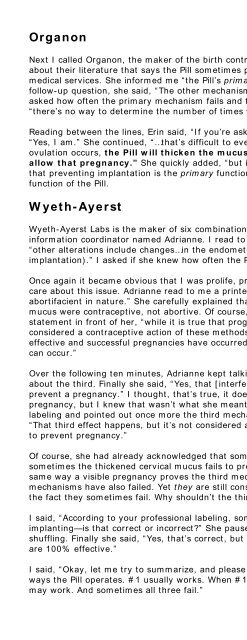Does the Birth Control Pill Cause Abortions
Does the Birth Control Pill Cause Abortions
Does the Birth Control Pill Cause Abortions
You also want an ePaper? Increase the reach of your titles
YUMPU automatically turns print PDFs into web optimized ePapers that Google loves.
Organon<br />
Next I called Organon, <strong>the</strong> maker of <strong>the</strong> birth control pill Desogen. After explaining my question<br />
about <strong>the</strong>ir literature that says <strong>the</strong> <strong>Pill</strong> sometimes prevents implantation, I was transferred to Erin in<br />
medical services. She informed me “<strong>the</strong> <strong>Pill</strong>’s primary mechanism is preventing ovulation.” After my<br />
follow-up question, she said, “The o<strong>the</strong>r mechanisms also happen, but <strong>the</strong>y’re secondary.” When I<br />
asked how often <strong>the</strong> primary mechanism fails and <strong>the</strong> secondary mechanisms kick in, she said<br />
“<strong>the</strong>re’s no way to determine <strong>the</strong> number of times which happens and which doesn’t.”<br />
Reading between <strong>the</strong> lines, Erin said, “If you’re asking if it’s an abortifacient…[pause]” I interjected,<br />
“Yes, I am.” She continued, “…that’s difficult to ever say that.” She added, “What happens is, if<br />
ovulation occurs, <strong>the</strong> <strong>Pill</strong> will thicken <strong>the</strong> mucus and thin <strong>the</strong> endometrium so that it doesn’t<br />
allow that pregnancy.” She quickly added, “but it’s not like <strong>the</strong> IUD.” I understood her to mean<br />
that preventing implantation is <strong>the</strong> primary function of <strong>the</strong> IUD, whereas it is only a secondary<br />
function of <strong>the</strong> <strong>Pill</strong>.<br />
Wyeth-Ayerst<br />
Wyeth-Ayerst Labs is <strong>the</strong> maker of six combination <strong>Pill</strong>s. I called and spoke with a medical<br />
information coordinator named Adrianne. I read to her <strong>the</strong> professional labeling of <strong>the</strong>ir <strong>Pill</strong>s that says<br />
“o<strong>the</strong>r alterations include changes…in <strong>the</strong> endometrium (which reduce <strong>the</strong> likelihood of<br />
implantation).” I asked if she knew how often <strong>the</strong> <strong>Pill</strong> prevents implantation.<br />
Once again it became obvious that I was prolife, presumably because no one but a prolifer would<br />
care about this issue. Adrianne read to me a printed statement that said “<strong>the</strong>se mechanisms are not<br />
abortifacient in nature.” She carefully explained that inhibiting ovulation and thickening <strong>the</strong> cervical<br />
mucus were contraceptive, not abortive. Of course, I agreed 100%. She <strong>the</strong>n said, reading from <strong>the</strong><br />
statement in front of her, “while it is true that progestins do alter <strong>the</strong> uterine lining, this is not<br />
considered a contraceptive action of <strong>the</strong>se methods. The fact that <strong>the</strong>se methods are not 100%<br />
effective and successful pregnancies have occurred clearly demonstrate that successful implantations<br />
can occur.”<br />
Over <strong>the</strong> following ten minutes, Adrianne kept talking about <strong>the</strong> first two mechanisms. I kept asking<br />
about <strong>the</strong> third. Finally she said, “Yes, that [interfering with implantation] occurs, but it doesn’t<br />
prevent a pregnancy.” I thought, that’s true, it doesn’t prevent a pregnancy, it actually ends a<br />
pregnancy, but I knew that wasn’t what she meant. I <strong>the</strong>n referred her back to Wyeth’s professional<br />
labeling and pointed out once more <strong>the</strong> third mechanism. She followed along with her copy and said,<br />
“That third effect happens, but it’s not considered a contraceptive action, because sometimes it fails<br />
to prevent pregnancy.”<br />
Of course, she had already acknowledged that sometimes <strong>the</strong> <strong>Pill</strong> fails to prevent ovulation and<br />
sometimes <strong>the</strong> thickened cervical mucus fails to prevent <strong>the</strong> sperm from fertilizing <strong>the</strong> egg. In <strong>the</strong><br />
same way a visible pregnancy proves <strong>the</strong> third mechanism has failed, it proves <strong>the</strong> o<strong>the</strong>r two<br />
mechanisms have also failed. Yet <strong>the</strong>y are still considered to be real mechanisms of <strong>the</strong> <strong>Pill</strong>, despite<br />
<strong>the</strong> fact <strong>the</strong>y sometimes fail. Why shouldn’t <strong>the</strong> third effect be treated <strong>the</strong> same way<br />
I said, “According to your professional labeling, sometimes your <strong>Pill</strong>s do prevent a fertilized egg from<br />
implanting—is that correct or incorrect” She paused for a very long time and I heard papers<br />
shuffling. Finally she said, “Yes, that’s correct, but not always…that’s why we can’t say contraceptives<br />
are 100% effective.”<br />
I said, “Okay, let me try to summarize, and please correct me if I’m wrong. There are three different<br />
ways <strong>the</strong> <strong>Pill</strong> operates. #1 usually works. When #1 fails, #2 may work. When #1 and #2 fail, #3<br />
may work. And sometimes all three fail.”



